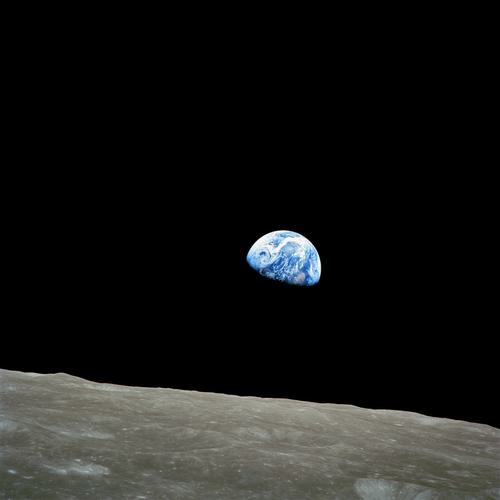

DEFINITION
Hannah Harrison
Climate Organiser and Communications Delegate
Perhaps the most influential environmental photograph ever taken, Earthrise captures the Earth and the surface of the moon from lunar orbit. Taken by Apollo 8 on Christmas Eve in 1968, Earthrise reaffirmed some of Earth's all too often forgotten characteristics: its fragility, deep beauty, and its status as our only home.
Though its philosophical significance was not immediate, Earthrise soon sunk into popular consciousness, complemented by Adlai Stevenson’s UN speech on Spaceship Earth and the publication of Rachel Carson’s best-selling “Silent Spring”. Both from the same decade as Earthrise, these hallmarks propelled the global environmental movement. Reiterating humanity’s connection with nature, they articulated the ecological issues facing the planet, and how much we have left to save.
Echoing values expressed across world religions, culture, and science, environmentalists hoped that Earthrise, showing the Earth at its most vulnerable, would reassert humanity’s place as part of nature. Hope grew that Earthrise would catalyse the action needed to save the non-human and human lives housed on our Spaceship Earth, as well as those to come. Individual lives are not visible in the photograph, but upon closer inspection, we are numerous and have the capacity to transform the world.

Earthrise, taken on December 24, 1968, by Apollo 8 astronaut William Anders. Lunar Orbit, 1968.
Photography By Public Domain
RESEARCH
Research by Estelle Ngoumtsa
Text by Sorah Park
Fact-checked by Hailey Basiouny
April 22, 2024
*text is up to date, although pending graphic adjustments
The historic Earthrise photograph was captured by NASA’s Apollo 8 team on Christmas Eve, 1968: the first time humans orbited the moon. This unplanned snapshot brought a new perspective of our planet during a time of warfare and political unrest. American astronauts Frank Borman, Jim Lovell, and William Anders who photographed the shot on their fourth orbit, were the first crew to spend Christmas in space. This view of Earth frames the colorful, blue and green planet in outer space as tiny and fragile in comparison to the moon’s rugged, pale surface. It became one of Life Magazine’s “100 Photographs That Changed the World” and is often credited as the driving force behind the global environmental movement. World-renowned nature photographer Galen Rowell described Earthrise as “the most influential environmental photograph ever taken”.
The first mission to the moon resulted in a photo that came to symbolize environmentalism. Not long after, Earth Day was recognized on April 22, 1970 and later propelled the creation of the U.S. Environmental Protection Agency. Astronaut Anders believes that Earthrise had a clear message for humanity and about its shared home, “This is the only home we have and yet we’re busy shooting at each other, threatening nuclear war, and wearing suicide vests. It amazes me.” Earthrise rose from the Space Race and Cold War era, on a nearly impossible NASA mission that required crew training and launch within four months. By 1968, the United States was losing the race to the moon against the Soviet Union. Earlier that year, Martin Luther King Jr. was assassinated, as was Robert F. Kennedy, and many ongoing anti-war sentiments and protests against the Vietnam War were taking place. However, the positive success of Apollo 8 provided a beacon of hope for Americans.
Many astronauts reported experiencing the “overview effect,” a transformative cognitive shift that occurs after viewing the Earth from space. Coined by space philosopher Frank White in 1987, the effect includes a deeper appreciation for the planet and an increased feeling of interconnection and unity amongst other beings. The popularity of Earthrise gave a glimpse of the overview effect to the masses. While space tourism is increasingly allowing extremely wealthy individuals to space travel, humans do not need to leave Earth to achieve the overview effect. A majority of us will never leave the planet, but you do not have to look too far to witness firsthand the fragility and beauty of Earth. With the climate crisis continuing to wreak havoc on the environment, we are running out of time to limit warming to 1.5°C above pre-industrial temperatures before some of its catastrophic effects become irreversible. We are connected by our shared home and it has been calling out to us for help. Another Earthrise moment is not necessary to remind us of our limited time on Earth. Simply existing on this planet is cause for concern and collective care for the tiny blue pearl we call home.
American poet Amanda Gorman’s poem ‘Earthrise’, dedicated to Al Gore for The Climate Reality Project, ends with these uplifting lines:
We relish the view;
We witness its round green and brilliant blue,
Which inspires us to ask deeply, wholly:
What can we do?
Open your eyes.
Know that the future of
this wise planet
Lies right in sight:
Right in all of us. Trust
this earth uprising.
All of us bring light to exciting solutions never tried before
For it is our hope that implores us, at our uncompromising core,
To keep rising up for an earth more than worth fighting for.
“Celebrating the Holiday Season in Space 2022.” 2022. NASA.
Spector, Dina, and Kelsey Vlamis. 2022. “The fascinating story behind 'Earthrise' — the most famous picture of Earth ever taken — which turns 54 today.” Business Insider India.
Druding, Josh. 2020. “Why “Earthrise” is the Most Influential Photo Ever Taken.” Medium.
Wall, Mike. 2022. “Earth Day at 50: How Apollo 8's 'Earthrise' photo helped spark the first celebration.”
Druding, Josh. 2020. “Why “Earthrise” is the Most Influential Photo Ever Taken.” Medium.
Carter, Jamie. 2018. “Apollo 8 Astronaut On How Crew Saw The Earth Rise, Won The Space Race And Saved Christmas Forever.” Forbes.
Siegel, Ethan. 2021. “William Shatner cried upon returning from space. The “overview effect” explains why.” Medium.
Gorman, Amanda. 2021. “Earthrise poem by Amanda Gorman.” Sierra Club.
RELATED WORDS
We use cookies to analyze site usage and enhance navigation. By accepting, you agree to our use of cookies. Accept
Subscribe to our newsletter and be the first to get news on climate literacy!

By submitting I confirm that I have read Climate Words’ privacy policy and agree that Climate Words may send me announcements to the email address entered above and that my data will be processed for this purpose in accordance with Climate Words’ privacy policy.